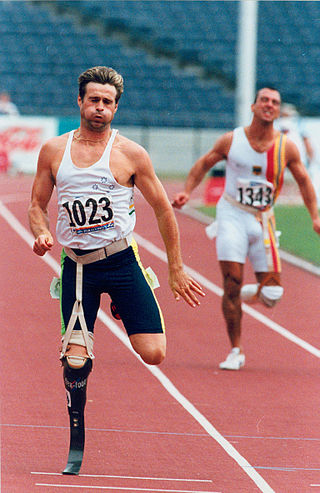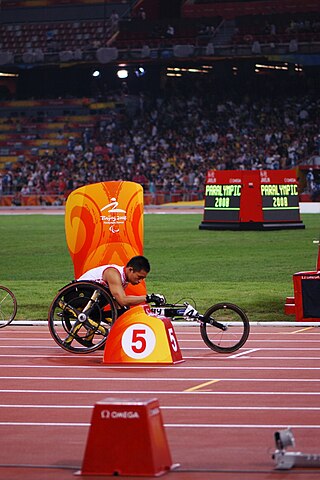Related Research Articles
The men's javelin throw at the 2011 IPC Athletics World Championships was held at the QEII Stadium from 22–29 January

T44 is a disability sport classification for disability athletics, applying to "Single below knee amputation or an athlete who can walk with moderately reduced function in one or both legs." It includes ISOD A4 and A9 classes.
T52 is disability sport classification for disability athletics. People in this class have good shoulder and upper body control, but lack fine motor skills in their arms and hands. They have no or limited trunk and leg function. The class includes people with a number of different types of disabilities including spinal cord injuries. Similar classifications are T51, T53 and T54.

T53 is disability sport classification for disability athletics. The class includes people with a number of different types of disabilities including spinal cord injuries. People in this class have full use of their arms but have no or limited trunk function. Similar classifications are T51, T52, and T54. People in this class have a functional upper limbs, but limited trunk usage and limited lower limb functionality. During classification, they both undergo a bench test of muscle strength and demonstrate their skills in athletics. People in this class include Tanni Grey-Thompson (GBR), Samantha Kinghorn (GBR), Angie Ballard (AUS) and Richard Colman (AUS).
F57 is a disability sport classification for disability athletics for people who compete in field events from a seated position. This class is for people with limb deficiencies not covered by other classes. It includes people who are members of the ISOD A1 and A9 classes. Events open to people in this class include the shot put, discus and javelin.
F56 is a disability sport classification for disability athletics for people who compete in field events from a seated position. The seating field event class used to be known as lower 4, upper 5. Different disability groups compete in this class, including people with amputations and spinal cord injuries. Events that may be on the program for F56 competitors include the discus throw, shot put and javelin.
F55 is a disability sport classification for disability athletics for people who compete in field events from a seated position. Sportspeople in this class have full arm function, partial trunk function and no lower limb function. Different disability groups compete in this class, including people with spinal cord injuries. The classification was previously known as lower 3, upper 4.
LA5 is a Les Autres sport classification is an ambulatory sport classification for a sportsperson with a disability that impacts their locomotor function. People in this class have normal upper limb functionality, but have problems with balance or use of their lower limbs. Generally, limb problems are confined to one limb.
F1, also T1 and SP1, is a wheelchair sport classification that corresponds to the neurological level C6. Historically, it was known as 1A Complete. People in this class have no sitting balance, and are tetraplegics. They may be able to perform limited actions with one hand. They lack sitting balance, and have limited head control and respiratory endurance. The process for classification into this class has a medical and functional classification process. This process is often sport specific.
F2, also T2 and SP2, is a wheelchair sport classification that corresponds to the neurological level C7. Historically, it was known as 1B Complete, 1A Incomplete. People in this class are often tetraplegics. Their impairment effects the use of their hands and lower arm, and they can use a wheelchair using their own power.
F3, also T3 and SP3, is a wheelchair sport classification that corresponds to the neurological level C8. Historically, it was known as 1C Complete, and 1B Incomplete. F3 sportspeople have functional issues related to the muscles in their throwing arm, though they have enough control over their fingers to grip a throwing implement normally. They have no functional trunk control.
F4, also T4 and SP4, is a wheelchair sport classification that corresponds to the neurological level T1- T7. Historically, it was known as 1C Incomplete, 2 Complete, or Upper 3 Complete. People in this class have normal upper limb function, and functional issues with muscles below the nipple line.
F5, also SP5, is a wheelchair sport classification that corresponds to the neurological level T8 - L1. Historically, it was known as Lower 3, or Upper 4. People in this class have some trunk function and good sitting balance. They have problems with hip function, that reduces their ability to rotate their spines.
F6, also SP6, is a wheelchair sport classification that corresponds to the neurological level L2 - L5. Historically, this class has been known as Lower 4, Upper 5. People in this class have good sitting balance, and good forward and backward movement of their trunk. They have some use of their thighs and can press their knees together.
F7, also SP7, is a wheelchair sport classification that corresponds to the neurological level S1- S2. Historically, it has been referred to as Lower 5. It is characterized by people having their lower limb muscles strength and function impacted. People in the SP7 class generally have good sitting balance and some trunk movement backwards and forwards. One side may be stronger than the other.
F8, also SP8, is a standing wheelchair sport classification open to people with spinal cord injuries, with inclusion based on a functional classification on a points system for lower limb functionality. Sportspeople in this class need to have less than 70 points. The class has largely been used in Australia and the United States. F8 has largely been eliminated because of a perceived lack of need internationally for a standing wheelchair class. Sports this class participates in include athletics, swimming and wheelchair basketball. In athletics, participation is mostly in field events.
Wheelchair sport classification is a system designed to allow fair competition between people of different disabilities, and minimize the impact of a person's specific disability on the outcome of a competition. Wheelchair sports is associated with spinal cord injuries, and includes a number of different types of disabilities including paraplegia, quadriplegia, muscular dystrophy, post-polio syndrome and spina bifida. The disability must meet minimal body function impairment requirements. Wheelchair sport and sport for people with spinal cord injuries is often based on the location of lesions on the spinal cord and their association with physical disability and functionality.
F54 is a disability sport classification for disability athletics for people who compete in field events from a seated position. Different disability groups compete in this class, including people with spinal cord injuries. Events that may be on the program for F54 competitors include the discus throw, shot put and javelin.

Libya competed at the 2016 Summer Paralympics in Rio de Janeiro, Brazil, from 7 September to 18 September 2016. The country has three sportspeople competing in two sports.

Afghanistan sent a delegation to compete at the 2016 Summer Paralympics in Rio de Janeiro, Brazil, from 7–18 September 2016. This was the nation's fifth time taking part in a Summer Paralympic Games. The Afghan delegation consisted of a single athlete, Mohammad Durani, who competed in the javelin throw. Originally he finished 16th in his event, but he was retroactively disqualified for a doping violation.
References
- 1 2 3 4 5 6 7 8 9 10 National Governing Body for Athletics of Wheelchair Sports, USA. Chapter 2: Competition Rules for Athletics. United States: Wheelchair Sports, USA. 2003.
- 1 2 3 4 Consejo Superior de Deportes (2011). Deportistas sin Adjectivos (PDF) (in European Spanish). Spain: Consejo Superior de Deportes. Archived from the original (PDF) on 2016-11-04. Retrieved 2016-07-28.
- 1 2 3 4 "OFFICIAL GUIDE & RULES OF GAMES 2006" (PDF). GAELIC ATHLETICS & CYCLE ASSOCIATION. 2006.
- 1 2 Foster, Mikayla; Loveridge, Kyle; Turley, Cami (2013). "S P I N A L C ORD I N JURY" (PDF). Therapeutic Recreation.
- 1 2 3 4 "National Junior Disabled Sports Championships 2004 Registration Packet" (PDF). Mesa Association of Sports for the Disabled. 2004.
- 1 2 3 USA Track & Field (2007). "Special Section Adaptions to the USA Track & Field Rules of Competition for Individuals with Disabilities" (PDF). USA Track & Field.
- 1 2 3 Chow, John W.; Kuenster, Ann F.; Lim, Young-tae (2003-06-01). "Kinematic Analysis of Javelin Throw Performed by Wheelchair Athletes of Different Functional Classes". Journal of Sports Science & Medicine. 2 (2): 36–46. ISSN 1303-2968. PMC 3938047 . PMID 24616609.
